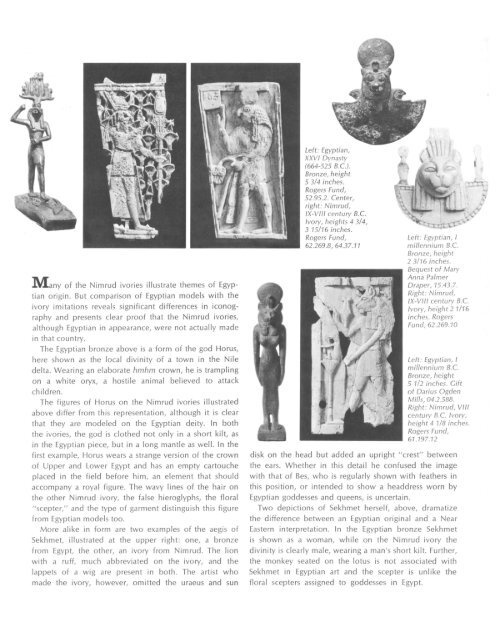The Metropolitan Museum of Art Bulletin, v. 29, no. 7 (March, 1971)
The Metropolitan Museum of Art Bulletin, v. 29, no. 7 (March, 1971)
The Metropolitan Museum of Art Bulletin, v. 29, no. 7 (March, 1971)
You also want an ePaper? Increase the reach of your titles
YUMPU automatically turns print PDFs into web optimized ePapers that Google loves.
Many <strong>of</strong> the Nimrud ivories illustrate themes <strong>of</strong> Egyptian<br />
origin. But comparison <strong>of</strong> Egyptian models with the<br />
ivory imitations reveals significant differences in ico<strong>no</strong>graphy<br />
and presents clear pro<strong>of</strong> that the Nimrud ivories,<br />
although Egyptian in appearance, were <strong>no</strong>t actually made<br />
in that country.<br />
<strong>The</strong> Egyptian bronze above is a form <strong>of</strong> the god Horus,<br />
here shown as the local divinity <strong>of</strong> a town in the Nile<br />
delta. Wearing an elaborate hmhm crown, he is trampling<br />
on a white oryx, a hostile animal believed to attack<br />
children.<br />
<strong>The</strong> figures <strong>of</strong> Horus on the Nimrud ivories illustrated<br />
above differ from this representation, although it is clear<br />
that they are modeled on the Egyptian deity. In both<br />
the ivories, the god is clothed <strong>no</strong>t only in a short kilt, as<br />
in the Egyptian piece, but in a long mantle as well. In the<br />
first example, Horus wears a strange version <strong>of</strong> the crown<br />
<strong>of</strong> Upper and Lower Egypt and has an empty cartouche<br />
placed in the field before him, an element that should<br />
accompany a royal figure. <strong>The</strong> wavy lines <strong>of</strong> the hair on<br />
the other Nimrud ivory, the false hieroglyphs, the floral<br />
"scepter," and the type <strong>of</strong> garment distinguish this figure<br />
from Egyptian models too.<br />
More alike in form are two examples <strong>of</strong> the aegis <strong>of</strong><br />
Sekhmet, illustrated at the upper right: one, a bronze<br />
from Egypt, the other, an ivory from Nimrud. <strong>The</strong> lion<br />
with a ruff, much abbreviated on the ivory, and the<br />
lappets <strong>of</strong> a wig are present in both. <strong>The</strong> artist who<br />
made the ivory, however, omitted the uraeus and sun<br />
Left: Egyptian,<br />
XXVI Dynasty<br />
(664-525 B.C.).<br />
Bronze, height<br />
5 3/4 inches.<br />
Rogers Fund,<br />
52.95.2. Center,<br />
right: Nimrud,<br />
IX-VIII century B.C.<br />
Ivory, heights 4 3/4,<br />
3 15/16 inches.<br />
Rogers Fund,<br />
62.269.8, 64.37.11<br />
Left: Egyptian, I<br />
millennium B.C.<br />
Bronze, height<br />
2 3/16 inches.<br />
Bequest <strong>of</strong> Mary<br />
Anna Palmer<br />
Draper, 15.43.7.<br />
Right: Nimrud,<br />
IX-VIII century B.C.<br />
Ivory, height 2 1/16<br />
inches. Rogers<br />
Fund, 62.269.10<br />
Left: Egyptian, I<br />
millennium B.C.<br />
Bronze, height<br />
5 1/2 inches. Gift<br />
<strong>of</strong> Darius Ogden<br />
Mills, 04.2.588.<br />
Right: Nimrud, VIII<br />
century B.C. Ivory,<br />
height 4 1/8 inches.<br />
Rogers Fund,<br />
61.197.12<br />
disk on the head but added an upright "crest" between<br />
the ears. Whether in this detail he confused the image<br />
with that <strong>of</strong> Bes, who is regularly shown with feathers in<br />
this position, or intended to show a headdress worn by<br />
Egyptian goddesses and queens, is uncertain.<br />
Two depictions <strong>of</strong> Sekhmet herself, above, dramatize<br />
the difference between an Egyptian original and a Near<br />
Eastern interpretation. In the Egyptian bronze Sekhmet<br />
is shown as a woman, while on the Nimrud ivory the<br />
divinity is clearly male, wearing a man's short kilt. Further,<br />
the monkey seated on the lotus is <strong>no</strong>t associated with<br />
Sekhmet in Egyptian art and the scepter is unlike the<br />
floral scepters assigned to goddesses in Egypt.

















